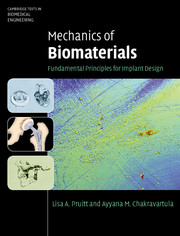Book contents
- Frontmatter
- Contents
- Symbols
- Prologue
- Part I Materials
- 1 Biocompatibility, sterilization, and materials selection for implant design
- 2 Metals for medical implants
- 3 Ceramics
- 4 Polymers
- 5 Mechanical behavior of structural tissues
- Part II Mechanics
- Part III Case studies
- Epilogue
- Appendix A Selected topics from mechanics of materials
- Appendix B Table of material properties of engineering biomaterials and tissues
- Appendix C Teaching methodologies in biomaterials
- Glossary
- Index
- References
4 - Polymers
from Part I - Materials
Published online by Cambridge University Press: 05 June 2012
- Frontmatter
- Contents
- Symbols
- Prologue
- Part I Materials
- 1 Biocompatibility, sterilization, and materials selection for implant design
- 2 Metals for medical implants
- 3 Ceramics
- 4 Polymers
- 5 Mechanical behavior of structural tissues
- Part II Mechanics
- Part III Case studies
- Epilogue
- Appendix A Selected topics from mechanics of materials
- Appendix B Table of material properties of engineering biomaterials and tissues
- Appendix C Teaching methodologies in biomaterials
- Glossary
- Index
- References
Summary
Inquiry
How would you design a polymeric suture anchor so that it offered strength for 6 months yet would be resorbed by the body within a year?
The above inquiry presents a realistic challenge that one might face in the field of tissue repair. Suture anchors are fixation devices used for the attachment of tendons and ligaments to bone. These devices are made up of the anchor itself, which is inserted into the bone using a screw mechanism or an interference fit and is often made of biodegradable polymers that dissolve in the body over time. The anchor also is equipped with an opening at its end and a securing suture is attached to the anchor through the eyelet of the anchor. The implant must be integrated into the underlying bone in order to provide structural support until the bone is able to support the necessary loads. Typically, a bioresorbable suture anchor is designed to provide structural integrity for up to 6 months and is often fully resorbed by the body within 1–2 years. The rate at which the polymer degrades is controlled primarily through its backbone chemistry, molecular weight, and crystallinity. The case study presented at the end of this chapter examines bioresorbable polymers as sutures and suture anchors.
Historical perspective and overview
Polymers have been utilized in medical implants for nearly 80 years. Polymethylmethacrylate (PMMA) was first used in the body in the 1930s and was initially chosen for its biocompatibility, stiffness, and optical properties. Today, PMMA is widely used as a medical implant in such applications as bone cement for dental and orthopedic applications (Kühn, 2000). In the decades following their introduction into the implant field, the use of polymers expanded in the body with a diverse range of applications including blood pumps, heart-lung machines, vascular grafts, angioplasty catheters, dental and orthopedic implants, and mammary prosthetics (ASM, 2003). Materials such as silicones, polyurethanes, and adhesives were employed; however, there were no stringent device regulations in place and many biomaterials fared poorly in the body. Although medical devices were regulated by the Food and Drug Administration (FDA), the 1938 Federal Food, Drug and Cosmetic Act did not require premarket approval for medical devices (this is discussed further in Chapter 6). In the 1960s and 1970s, developments in heart valve technology, orthopedics, sutures, dental materials, and soft tissue reconstruction prevailed. Early heart valve cages made of silicones fared poorly due to lipid adsorption, polyurethane foams used on the surface of mammary prosthetics for better adhesion were susceptible to chronic inflammatory response, and the use of polytetrafluoroethylene (PTFE) as a bearing surface in both dental and orthopedic implants was complicated by high wear rates and premature device failures (Feinerman and Piecuch, 1993; Zardenta et al., 1996). Starting in 1976, medical devices were subject to pre-market approval by the FDA. Throughout the decades that followed, the implementation of regulatory constraints on medical implants, certain material applications, such as silicone breast implants and PTFE used in dental implants, were removed (silicone was temporarily banned by the FDA and later reapproved for use in breast implants) from the biomaterials market, while other polymers such as ultra-high molecular weight polyethylene (UHMWPE) used in total joint replacements became the mainstay of the orthopedics industry. Much of the past two decades has focused on the improvement of polymers known to perform well in the body. A summary of current uses for polymers in orthopedics, dentistry, cardiovascular, and soft tissue implants is given in Table 4.1.
- Type
- Chapter
- Information
- Mechanics of BiomaterialsFundamental Principles for Implant Design, pp. 92 - 128Publisher: Cambridge University PressPrint publication year: 2011



